Commanders of World War II: Difference between revisions
Appearance
Content deleted Content added
Blueshirts (talk | contribs) →{{flagicon|Taiwan}} [[Republic of China]]: corrected and added some info |
m Date/fix maintenance tags |
||
| Line 1: | Line 1: | ||
{{ |
{{Unreferenced|date=November 2006}} |
||
The '''Commanders of [[World War II]]''' were for the most part career soldiers {{verification needed}}. They were forced to adapt to new technologies and shaped the direction of modern warfare. Some political leaders, particularly those of the principal dictatorships involved in the conflict, [[Adolf Hitler]] (Germany), [[Joseph Stalin]] (USSR) and [[Benito Mussolini]] (Italy), acted as supreme military commanders as well as civil commanders of their respective countries or empires<ref name="TOCTWW2">{{cite book|coauthors=I.C.B Dear, M.R.D. Foot|title=Oxford Companion to the Second World War|edition=paperback|publisher=[[Oxford University Press]]|date=2005|id=ISBN 0-1928-0666-1}}</ref>. |
The '''Commanders of [[World War II]]''' were for the most part career soldiers {{verification needed}}. They were forced to adapt to new technologies and shaped the direction of modern warfare. Some political leaders, particularly those of the principal dictatorships involved in the conflict, [[Adolf Hitler]] (Germany), [[Joseph Stalin]] (USSR) and [[Benito Mussolini]] (Italy), acted as supreme military commanders as well as civil commanders of their respective countries or empires<ref name="TOCTWW2">{{cite book|coauthors=I.C.B Dear, M.R.D. Foot|title=Oxford Companion to the Second World War|edition=paperback|publisher=[[Oxford University Press]]|date=2005|id=ISBN 0-1928-0666-1}}</ref>. |
||
==Military Commanders== |
==Military Commanders== |
||
| ⚫ | |||
| ⚫ | |||
===={{UK}}==== |
===={{UK}}==== |
||
{| class="wikitable" |
{| class="wikitable" |
||
| Line 109: | Line 108: | ||
* [[Battle of Britain]] |
* [[Battle of Britain]] |
||
* [[Battle of Normandy]] |
* [[Battle of Normandy]] |
||
* [[ |
* [[RAF Bomber Command#Strategic bombing 1942-45|Strategic bombing of Germany]] |
||
|-bgcolor="#EDF1F1" |
|-bgcolor="#EDF1F1" |
||
| colspan="7"|Held back the [[Luftwaffe]] at the Battle of Britain. Continually launched air raids against Germany.<ref name="TOCTWW2" /> |
| colspan="7"|Held back the [[Luftwaffe]] at the Battle of Britain. Continually launched air raids against Germany.<ref name="TOCTWW2" /> |
||
| Line 461: | Line 460: | ||
| |
| |
||
* [[Invasion of Poland (1939)]] |
* [[Invasion of Poland (1939)]] |
||
* [[ |
* [[Polish contribution to World War II#Polish Armed Forces in the West|Polish Armed Forces in the West]] |
||
|-bgcolor="#EDF1F1" |
|-bgcolor="#EDF1F1" |
||
| colspan="7"| Served as Commander-in-Chief of the Polish government in exile, and formed the [[Polish Armed Forces]].<ref name="TOCTWW2"/> |
| colspan="7"| Served as Commander-in-Chief of the Polish government in exile, and formed the [[Polish Armed Forces]].<ref name="TOCTWW2"/> |
||
| Line 478: | Line 477: | ||
|} |
|} |
||
==== |
====22px 22px France==== |
||
{| class="wikitable" |
{| class="wikitable" |
||
| Line 541: | Line 540: | ||
|} |
|} |
||
===={{flagicon|Taiwan}} |
===={{flagicon|Taiwan}} Republic of China==== |
||
{| class="wikitable" |
{| class="wikitable" |
||
| Line 616: | Line 615: | ||
|} |
|} |
||
==== |
====22px Greece==== |
||
{| class="wikitable" |
{| class="wikitable" |
||
|- |
|- |
||
| Line 641: | Line 640: | ||
|} |
|} |
||
==== |
====22px Netherlands==== |
||
{| class="wikitable" |
{| class="wikitable" |
||
| Line 679: | Line 678: | ||
|} |
|} |
||
==== |
====22px 22px Yugoslavia==== |
||
{| class="wikitable" |
{| class="wikitable" |
||
| Line 707: | Line 706: | ||
===Axis Powers=== |
===Axis Powers=== |
||
====22px Germany==== |
|||
====[[Image:Flag of Germany 1933.svg|22px]] [[Germany]]==== |
|||
{| class="wikitable" |
{| class="wikitable" |
||
|- |
|- |
||
| Line 927: | Line 925: | ||
|} |
|} |
||
==== |
====22px Italy==== |
||
{| class="wikitable" |
{| class="wikitable" |
||
| Line 975: | Line 973: | ||
|} |
|} |
||
===={{flagicon|Japan}} |
===={{flagicon|Japan}} Japan==== |
||
{| class="wikitable" |
{| class="wikitable" |
||
|- |
|- |
||
| Line 1,022: | Line 1,020: | ||
| colspan="7"| Son of former PM [[Terauchi Masatake]], became the senior officer of the Imperial Japanese after the coup of 1936. Was at one time considered as Tojo successor after the latter's resignation. |
| colspan="7"| Son of former PM [[Terauchi Masatake]], became the senior officer of the Imperial Japanese after the coup of 1936. Was at one time considered as Tojo successor after the latter's resignation. |
||
|-bgcolor="#ffffff" |
|-bgcolor="#ffffff" |
||
| rowspan="2"|[[Shunroku Hata]]{{ |
| rowspan="2"|[[Shunroku Hata]]{{Fact|date=February 2007}} |
||
| |
| |
||
| [[Field Marshal]] |
| [[Field Marshal]] |
||
| Line 1,048: | Line 1,046: | ||
| colspan="7"| Defender of the Phillipines against MacArthur.<ref name="TOCTWW2"/> |
| colspan="7"| Defender of the Phillipines against MacArthur.<ref name="TOCTWW2"/> |
||
|-bgcolor="#ffffff" |
|-bgcolor="#ffffff" |
||
| rowspan="2"|[[Iwane Matsui]]{{ |
| rowspan="2"|[[Iwane Matsui]]{{Fact|date=February 2007}} |
||
| |
| |
||
| [[General]] |
| [[General]] |
||
| Line 1,160: | Line 1,158: | ||
|} |
|} |
||
==== |
====22px Romania==== |
||
{| class="wikitable" |
{| class="wikitable" |
||
|- |
|- |
||
| Line 1,196: | Line 1,194: | ||
|} |
|} |
||
==See |
==See also== |
||
[[World War II Allied Leaders]] |
[[World War II Allied Leaders]] |
||
| Line 1,203: | Line 1,201: | ||
See http://en.wikipedia.org/wiki/Wikipedia:Footnotes for an explanation of how to generate footnotes using the <ref> and </ref> tags, and the template below. |
See http://en.wikipedia.org/wiki/Wikipedia:Footnotes for an explanation of how to generate footnotes using the <ref> and </ref> tags, and the template below. |
||
</nowiki>--> |
</nowiki>--> |
||
{{FootnotesSmall|resize=100%}} |
{{FootnotesSmall|resize=100%}} |
||
[[Category:Military personnel of World War II]] |
[[Category:Military personnel of World War II]] |
||
Revision as of 18:30, 8 February 2007
The Commanders of World War II were for the most part career soldiers [verification needed]. They were forced to adapt to new technologies and shaped the direction of modern warfare. Some political leaders, particularly those of the principal dictatorships involved in the conflict, Adolf Hitler (Germany), Joseph Stalin (USSR) and Benito Mussolini (Italy), acted as supreme military commanders as well as civil commanders of their respective countries or empires[1].
Military Commanders
Allied Powers
| Armed Force | Name | Highest Rank | Highest Award | Fate | Casualties inflicted | Theatres / Battles | |
|---|---|---|---|---|---|---|---|
| Army | Alan Brooke | File:AlanbrookeBook.jpg | Field Marshal | 1st Viscount Alanbrooke | Chancellor of Queen's University Belfast[verification needed]. |
| |
| Commanded the II corps of the British Expeditionary Force at the Battle of France. Later served as the Chief of the Imperial General Staff.[1] | |||||||
| Bernard Montgomery | 
|
Field Marshal | 1st Viscount of El Alamein, Knight of the Garter. | Served as CIGS, and deputy leader of NATO. | |||
| A veteran of the Irish War of Independence, entered the Second World War as part of the British Expeditionary Force, defending France. Was part of the evacuation of Dunkirk. Won the Battle of El Alamein and the Battle of Sicily before heading the British Forces at the Battle of Normandy and the rest of the Western Campaign.[1][2] | |||||||
| Harold Alexander | Field Marshal | 1st Earl of Tunis. | Governor General of Canada. | ||||
| The last British soldier to evacuate Dunkirk, replaced Auchinleck from command at North Africa, and turned the tide in the allies favour. After defeating the Germans in North Africa, staged a successful invasion of Italy, liberating it in 1944/5.[1] | |||||||
| Archibald Wavell | 
|
Field Marshal | 1st Earl Wavell | Viceroy of India, returned to England in 1947 and became High Steward of Colchester. | |||
| Commander-in-Chief of British Forces in the Middle East 1939–1941. Commander-in-Chief in India 1941–1942. Commander of ABDACOM 1942. Commander-in-Chief in India 1942–1943. Viceroy of India 1943-1947.[1] | |||||||
| John Vereker | Field Marshal | 6th Viscount Gort. Holder of the Victoria Cross (WWI). | Died in 1946. | ||||
| A world war I hero, he played a major role in mobilising and arming the British forces during the Phony War. He took command of the British Expeditionary Force for the German invasion of France, and despite courageous fighting, was overwhelmed by German military tactics. When his troops were trapped in Dunkirk, he disobeyed orders from French and British command to attack and decided to evacuate, a decision which saved the lives of over 300,000 soldiers. [1] | |||||||
| Claude Auchinleck | 
|
Field Marshal | Order of the Bath | Commander-in-Chief, India | |||
| Organised the Home Guard to protect against Operation Sealion. A quick response to the Iraq revolt impressed Churchill, who appointed him Commander-in-Chief of the North Africa forces. Frequent disagreements with British command, coupled with significant loss of territory against Rommel (with the exception of Tobruk), forced him to be reassigned back to India. He fared better in this theatre, successfully mobilising Indian forces against the Burma invasion.[1] | |||||||
| Air Force | Charles Portal | File:Sikorski Portal Dyon 300.jpg | Marshal of the Royal Air Force | Distinguished Flying Cross[verification needed], 1st Viscount Portal of Hungerford. | Chairman of British Aircraft Corporation[verification needed]. | ||
| Held back the Luftwaffe at the Battle of Britain. Continually launched air raids against Germany.[1] | |||||||
| Royal Navy | Dudley Pound | Admiral of the Fleet | Knight of the British Empire | Died of illness, October 1943. | |||
| First Sea Lord 1939-1943. [1] | |||||||
| Andrew Cunningham | 
|
Admiral of the Fleet | Distinguished Service Order[verification needed], 1st Viscount of Hyndhope | ||||
| First Sea Lord 1943-1946. [1] | |||||||
| Armed Force | Name | Highest Rank | Highest Award | Fate | Casualties inflicted | Theatres / Battles | |
|---|---|---|---|---|---|---|---|
| Army | George Marshall | 
|
General of the Army | Distinguished Service Medal[verification needed], Silver Star[verification needed], GCB[verification needed] | Established the Marshall Plan, for which he won the Nobel Peace Prize. | ||
| Mentored by General Pershing. Led the rapid growth of US forces, co-ordinated the Western Allies and promoted postwar reconstruction of Europe.[1] | |||||||
| Dwight D Eisenhower | 
|
General of the Army | Distinguished Service Medal[verification needed], Medal of Honor (offered)[verification needed]. | After liberating Europe, served as NATO head before being elected the 34th President of the United States. | |||
| Entered the war as an assistant to the more senior Officers MacArthur and George Patton, showed his worth as a commander during the North Africa Campaign, before being chosen by Roosevelt to head the liberation of Europe on the Western Front as commander of SHAEF.[1] | |||||||
| Omar Bradley | 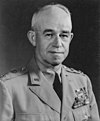
|
General | Distinguished Service Medal (Army and Navy)[verification needed]. | Became Chairman of the Joint Chiefs of Staff [verification needed] | |||
| This former infantry school instructor entered the war under Patton, and towards the end of the war, led a force of over 1.3 million troops (America's largest to serve under one man).[1] | |||||||
| George S. Patton | 
|
General | Distinguished Service Cross [verification needed] | Died in a road accident 4 months after the end of the war. | |||
| An aggressive general whose ferocious military thrusts earned him admiration and respect from all participants in the war (and at times endangered his military career). Successfully used the German tactic of armored blitzkrieg against the Germans.[1] | |||||||
| Douglas MacArthur | 
|
General of the Army | Medal of Honor[verification needed], Philippine Medal of Valor[verification needed] | Tasked with rebuilding Japan after the war. Later involved in the Korean War. | |||
| Recalled from retirement prior to the start of the Pacific war, was disappointed to relinquish the Philippines to the Japanese. Promising to return, he did so in 1945 and whilst in Manila, prepared for war in Japan itself[verification needed].[1] | |||||||
| Navy | Ernest King | 
|
Fleet Admiral | Navy Cross[verification needed] | Retired on December 15, 1945. | ||
| [1] | |||||||
| Chester Nimitz | File:Chester Nimitz.jpg | Fleet Admiral | Distinguished Service Medal[verification needed] | Served as Chief of Naval Operations. | |||
| After the attack on Pearl Harbour, took command of the Pacific Ocean areas, and turned around USA's fortunes in the Battle of Midway. Closed the war with operations in the Leyte Gulf and Okinawa. [1] | |||||||
| William Halsey, Jr. | 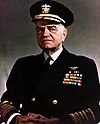
|
Admiral | Navy Cross | Retired 1947. | |||
| Commander of South Pacific Area 1942-1944. Commander of United States Third Fleet 1944-1945.[1][3] | |||||||
| Frank Jack Fletcher | 
|
Vice Admiral | Medal of Honor[verification needed] | Chairman of the General Board[verification needed], retired in 1947[verification needed]. | |||
| Sunk 6 enemy carriers[verification needed]. In November 1942, he became Commander, Thirteenth Naval District and Commander, Northwestern Sea Frontier [verification needed]. A year later, he was placed in charge of the Northern Pacific area [according to Oxford companion to second world war, this occurred in October 1942].[1] | |||||||
| Air Force | Henry Arnold | 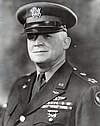
|
General of the Army | Head of the USAAF[1] | |||
| Member of the US Joint Chiefs of Staff, and the Combined Chiefs of Staff committees.[1] | |||||||
| Ira Clarence Eaker | 
|
Lieutenant General | Became deputy commander of the Army Air Forces until retirement in 1947. | ||||
| Commander of the 8th US Bomber command.[1] | |||||||
| Carl Spaatz | 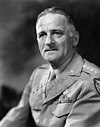
|
Major General | Replaced Arnold in September 1947 to become chief of the US Air Force. |
| |||
| One of the pioneers of US military aviation, Spaatz advocated the use of scientific analysis to bombing raids, and made effective use of long range fighters, tactics which helped the Allies achieve air superiority over Europe. [1] | |||||||
| Armed Force | Name | Highest Rank | Highest Award | Fate | Casualties inflicted | Theatres / Battles | |
|---|---|---|---|---|---|---|---|
| Army | Georgy Zhukov | File:Georgij Žukov-1.jpg | Marshal of the Soviet Union | Twice an Order of Victory[verification needed], four times Hero of the Soviet Union[verification needed] | Became Soviet member of the Allied Control Council for Germany. | ||
| Successfully led the defence of Moscow and later relieved Leningrad. After vying with Rokossovsky for overall command, he led all Soviet armies in the closing stages of the war and at the Battle for Berlin [1]. | |||||||
| Konstantin Rokossovsky | File:Rokossovsky.jpg | Marshal of the Soviet Union | Order of Victory[verification needed] | Polish Defense Minister[verification needed] | |||
| Decisive role in the Battle for Moscow, led encirclement forces at Stalingrad, broke German counter-attack at Kursk, advanced into Poland and eventually linked up with the Americans at Wismar.[1] | |||||||
| Aleksandr Vasilevsky | File:Ac.vasilievski2.jpg | Marshal of the Soviet Union | Twice a Order of Victory[verification needed], twice Hero of the Soviet Union[verification needed]. | Soviet Defence Minister[verification needed] | |||
| Stalin's strategic specialist who planned and carried through many successful Soviet operations as overall commander, particularly the encirclement at Stalingrad and the grand plan for Bagration. Commander-in-Chief of Soviet Forces in the Far East during Operation August Storm.[1] | |||||||
| Nikolai Vatutin | File:Vatutin.jpg | General of the Army | Killed by the Ukrainian Insurgent Army.[verification needed] | ||||
| Deputy of the Chief of the General Staff of the Red Army[verification needed]. Decisive Soviet commander at Kursk[verification needed], outmanouvered German commander Manstein[verification needed] and later routed German forces in Korsun salient[verification needed].[1][Alternate reference needed] | |||||||
| Ivan Konev | 
|
Marshal of the Soviet Union | Order of Victory[verification needed], Hero of the Soviet Union[verification needed] | Appointed head of the Soviet forces in East Germany.[verification needed] | |||
| [1] | |||||||
| Semyon Timoshenko | File:Semyon Konstantinovich Timoshenko (1895-1970), Soviet military commander.jpg | Marshal of the Soviet Union | Order of Victory[verification needed], twice a Hero of the Soviet Union[verification needed]. | Soviet Army commander in Belarus[verification needed] | |||
| Soviet Navy | Nikolai Kuznetsov[verification needed] | File:Ac.kuznetsov.jpg | Admiral of the Fleet[verification needed] | Hero of the Soviet Union[verification needed] | Deputy Minister of the USSR Armed Forces[verification needed] and Commander-in-Chief of the Naval Forces.[verification needed] |
| |
| [verification needed] | |||||||
| Armed Force | Name | Highest Rank | Highest Award | Fate | Casualties inflicted | Theatres / Battles | |
|---|---|---|---|---|---|---|---|
| Army | Edward Rydz-Śmigły | 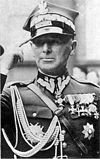
|
Marshal of Poland | Order of the White Eagle[verification needed] | Suffered heart attack[verification needed] before he could participate in the Polish resistance. | ||
| Was commander-in-chief of Poland during its invasion by German and Russian troops.[1] | |||||||
| Władysław Sikorski | 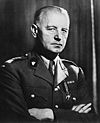
|
General | Died in plane crash July 1943. | ||||
| Served as Commander-in-Chief of the Polish government in exile, and formed the Polish Armed Forces.[1] | |||||||
| Tadeusz Bór-Komorowski | 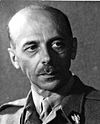
|
Lieutenant General | Order of the White Eagle[verification needed] | Elected Prime Minister of Polish government in Exile. | |||
| Commanded the main part of the Warsaw Uprising.[1] | |||||||
22px 22px France
| Armed Force | Name | Highest Rank | Highest Award | Fate | Casualties inflicted | Theatres / Battles | |
|---|---|---|---|---|---|---|---|
| Army | Charles de Gaulle | File:Cdgaulle.jpg | Brigade General | Grand Master Legion of Honor | Took control of France as President and was instrumental in creating the Fifth French Republic. | ||
| Defied Vichy France by vowing to continue fighting after the French surrender. He headed the Free French Forces, who assisted the Allies in the liberation of France in 1944.[1] | |||||||
| Maurice Gamelin | 
|
General | Died in 1958. | ||||
| Commander-in-Chief of French army during Battle of France, was replaced in 20 May 1940. [1] | |||||||
| Maxime Weygand | File:General maxime weyland.jpg | General | Arrested on charges of treason but acquitted. | ||||
| Commander-in-Chief of French army during the Battle of France from 20 May 1940 until the surrender of France. Oversaw the creation of the Weygand line, an early application of the Hedgehog tactic.[1] | |||||||
| French Navy | François Darlan | File:Darlan.jpg | Admiral of the Fleet | Murdered by Bonnier de La Chapelle December 1942. | |||
| Built up the French Navy to prepare for war, only to see it destroyed by the British Navy. Served the Vichy France government and was tipped to become Pétain's successor. Was commander of Vichy French forces in Operation Torch. After arranging a ceasefire, he defected to the Allied side.[1] | |||||||
| Armed Force | Name | Highest Rank | Highest Award | Fate | Casualties inflicted | Theatres / Battles | |
|---|---|---|---|---|---|---|---|
| Army | Chiang Kai-shek | 
|
Generalissimo | After the war against Japan, resumed civil war against the communists. Retreated to Taiwan and led the Kuomintang government there until his death. | |||
| both the head of the Republic of China and the supreme Allied commander in the China Theatre. Led the nation to total war from his temporary capital at Chongqing. | |||||||
| Mao Zedong | File:Mao-tiananmen-portrait.jpg | Head of the Chinese Communist Party | Defeated the Kuomintang in the civil war and established the People's Republic of China. | ||||
| greatly expanded communist base areas during the war, and eventually usurped control of China from Kuomintang.[1] | |||||||
| Yan Xishan | File:Yan Xishan.gif | General | Fought on the side of the Republic of China in the civil war. | ||||
| warlord of Shanxi | |||||||
| Li Zongren | 
|
General | Fought on the side of the Republic of China in the civil war. | ||||
| Xue Yue | File:Sitok.png | General | Fought on the side of the Republic of China in the civil war. | ||||
22px Greece
| Armed Force | Name | Highest Rank | Highest Award | Fate | Casualties inflicted | Theatres / Battles | |
|---|---|---|---|---|---|---|---|
| Army | Alexander Papagos | File:Alexandros Papagos.jpg | Lieutenant General | Led Greek army in Greek Civil War and later became the country's Prime Minister. | |||
| Was Commander-in-Chief of Greek Army during World War II.[1] | |||||||
22px Netherlands
| Armed Force | Name | Highest Rank | Highest Award | Fate | Casualties inflicted | Theatres / Battles | |
|---|---|---|---|---|---|---|---|
| Army | Henri Winkelman | File:Winkelman.jpg | General | Order of William[verification needed] | Died in 1952. | ||
| Was Commander-in-Chief of the Netherlands army during the Battle of the Netherlands.[1] | |||||||
| Navy | Karel Doorman | File:Doorman, KWFM.jpg | Rear admiral | Died in Battle of the Java Sea. | |||
| Commander of the combined American, British, Dutch and Australian (ABDA) fleet in the Dutch East Indies[1]. | |||||||
22px 22px Yugoslavia
| Armed Force | Name | Highest Rank | Highest Award | Fate | Casualties inflicted | Theatres / Battles | |
|---|---|---|---|---|---|---|---|
| Army | Josip Broz Tito | File:Titoweb.jpg | Marshal of Yugoslavia | Became leader of Yugoslavia. | |||
| Led Yugoslav Partisans.[1] | |||||||
Axis Powers
22px Germany
| Armed Force | Name | Highest Rank | Highest Award | Fate | Casualties inflicted | Theatres / Battles | |
|---|---|---|---|---|---|---|---|
| Army | Wilhelm Keitel | File:Keitel 01.jpg | Field Marshal | Executed in 1946. | |||
| Chief of the OKW during World War II.[1] | |||||||
| Alfred Jodl | 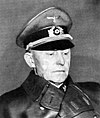
|
Colonel General | Executed in 1946. | ||||
| Chief of the Operations Staff of the OKW.[1] | |||||||
| Walther von Brauchitsch | File:Von Brauchitsch.jpg | Field Marshal | Died in 1948. | ||||
| Commander-in-Chief of Wehrmacht 1938-1941. | |||||||
| Gerd von Rundstedt | File:Von Rundstedt.jpg | Field Marshal | Knight's Cross of the Iron Cross with Oakleaves and Swords[4] | Died in 1953. | |||
| A Kriegsakademie graduate of the Prussian nobility, and a major World War I veteran, Rundstedt distinguished himself as commander of numerous fronts of World War II including the Western and Eastern fronts of Europe.[1] | |||||||
| Fedor von Bock | File:Bock color3.jpg | Field Marshal | Was killed in bombing raid in 1945. | ||||
| Recipient of the Pour le Mérite from World War I, rose rapidly in rank to Field marshal by the Fall of France. Took command of Army Group Centre, whose Panzer Groups penetrated the furthest into Russia.[1] | |||||||
| Erich von Manstein | File:Von Manstein 01.jpg | Field Marshal | Knight's Cross of the Iron Cross with Oakleaves and Swords[4] | Imprisoned after war, later released and served as senior advisor of Bundeswehr.[verification needed] | |||
| The master of mobile battle, authored the original Sichelschnitt plan, a plan which enabled Germany to capture France with minimal casualties.[1] | |||||||
| Erwin Rommel | File:Rommel portrait.jpg | Field Marshal | Knight's Cross of the Iron Cross with Oakleaves, Swords and Diamonds[4] | Committed suicide in 1944. | |||
| A legend in his own time, The Desert Fox headed the German campaign of North Africa. he made an immediate impact in the Saharan desert, conquering all of West Africa and threatening to reach Suez. Unfortunately due to a number of factors such as stretching supply lines and the reinforcement of Allied military power (both in Morroco and Egypt) turned the tide in the favour of the Allies, and his forces were routed in the Battle of Tunisia in 1943. Before he could counterattack, German high command reassigned him to defend the Atlantic Wall. Poor intelligence and overmanipulation by the Wehrmacht made led to the allied invasion of Normandy, which Rommel failed to stop. Though typically linked to the assasination of Hitler, Rommel probably did not take part in the July Plot as he did not want future generations to think that the Axis lost the war due to backstabbing. Nevertheless, Rommel had to commit suicide, lest he face a mock-trial which would have surly ended in the death of him, his family and his aides.[1] | |||||||
| Walter Model | 
|
Field Marshal | Knight's Cross of the Iron Cross with Oakleaves, Swords and Diamonds[4] | Committed suicide in 1945. | |||
| German Army officer whose expertise in defensive warfare earnt him the nickname of the 'Führer's fireman'[1] | |||||||
| Heinz Guderian | File:Heinz Guderian official.jpg | Colonel General | Knight's Cross of the Iron Cross with Oak Leaves[4] | Died in 1954. | |||
| Main creator of Blitzkrieg tactics. Chief of OKH General Staff 1944-1945.[1] | |||||||
| Air force | Hermann Göring | File:Hermann Wilhelm Goering Offiziell.jpg | Reichsmarschall | Grand Cross of the Iron Cross[4] | Committed suicide in 1946. | ||
| Commander-in-Chief of Luftwaffe 1935-1945.[1] | |||||||
| Albert Kesselring | File:Kesselring-albert.jpg | Field Marshal | Knight's Cross of the Iron Cross with Oakleaves, Swords and Diamonds[4] | Died in 1960 at the age of 75. | |||
| Was Commander in Chief of Luftwaffe South (1941-1943), then South-west (1943-1945), then West Europe (1945)[1] | |||||||
| Wolfram von Richthofen[verification needed] | File:Wolfram von Richthofen.jpg | Field Marshal | Knight's Cross of the Iron Cross with Oak Leaves[4] | Died in 1945. | |||
| Navy | Erich Raeder | File:Raeder 2 1.jpg | Grand Admiral | Committed suicide in 1960. | |||
| Commander-in-Chief of Kriegsmarine 1936-1943.[1] | |||||||
| Karl Dönitz | File:Karl Doenitz Color.jpg | Grand Admiral | Knight's Cross of the Iron Cross with Oak Leaves[4] | Briefly became President of Germany. Spent 10 years in prison. Died in 1980. | |||
| Commander-in-Chief of Kriegsmarine 1943-1945.[1] | |||||||
22px Italy
| Armed Force | Name | Highest Rank | Highest Award | Fate | Casualties inflicted | Theatres / Battles | |
|---|---|---|---|---|---|---|---|
| Army | Pietro Badoglio | Marshal of Italy | Duke of Addis Abeba | Succeeded Mussolini and arranged an Armistice of his country with the Allies. | |||
| Was not in favour of Italy's alliance to Germany, and resigned after the Battle of Greece.[1] | |||||||
| Ugo Cavallero | Marshal of Italy | Committed suicide after alienating both Germany and non-fascist Italy. | |||||
| Chief of the Italian Supreme Command 1940-1943.[1] | |||||||
| Navy | Arturo Riccardi[verification needed] | Admiral | Removed from office by Badoglio | ||||
| Served as Chief of staff of the Italian Navy. | |||||||
| Armed Force | Name | Highest Rank | Highest Award | Fate | Casualties inflicted | Theatres / Battles | |
|---|---|---|---|---|---|---|---|
| Army | Hideki Tojo | File:Tojo3.jpg | General | Executed in 1948. | |||
| Prime minister of Japan 1941-1944 was also a military commander. Chief of the Army General Staff in 1944.[1] | |||||||
| Hajime Sugiyama | 
|
Field Marshal | Committed suicide shortly after the end of the war. | ||||
| Chief of the Army General Staff 1940-1944.[1] | |||||||
| Hisaichi Terauchi | 
|
Field Marshal | Order of the Rising Sun | Died in a prisoner of war camp in Malaya June 1946. | |||
| Son of former PM Terauchi Masatake, became the senior officer of the Imperial Japanese after the coup of 1936. Was at one time considered as Tojo successor after the latter's resignation. | |||||||
| Shunroku Hata[citation needed] | Field Marshal | Sentenced to imprisonment. | |||||
| Tomoyuki Yamashita | 
|
General | Executed at 1946. | ||||
| Defender of the Phillipines against MacArthur.[1] | |||||||
| Iwane Matsui[citation needed] | General | Retired 1938, executed in 1948. | |||||
| Navy | Osami Nagano[verification needed] | File:OsaNag.jpg | Fleet Admiral | Died of a heart attack in 1947. | |||
| Chief of the Navy General Staff. | |||||||
| Isoroku Yamamoto | File:Yamamoto-Isoroku-improvedContrast.jpg | Fleet Admiral | Order of the Chrysanthemum[verification needed] | Assassinated by USA in 1943. | |||
| Commander-in-Chief of the Imperial Japanese Navy 1939-1943.[1] | |||||||
| Mineichi Koga | Fleet Admiral | Knight's Cross of the Iron Cross with Oak Leaves[4] | Killed in plane crash 1944. | ||||
| Commander-in-Chief of the Imperial Japanese Navy 1943-1944.[1] | |||||||
| Soemu Toyoda | Fleet Admiral | Died in 1957 at the age of 73. | |||||
| Commander-in-Chief of the Imperial Japanese Navy 1944-1945.[1] | |||||||
| Chuichi Nagumo | 
|
Vice Admiral | Order of the Rising Sun[verification needed] | Committed suicude in 1944 during the battle of Saipan. | |||
| Torpedo specialist and commander of the Carrier Striking Task Force that attacked Pearl Harbor. Successful raids at Darwin and the Indian Ocean were reversed at the Battle of Midway. Although he had tactical victories in the Guadalcanal campaigns, his battle strength was severely depleted, and was switched to the defence of the Mariana Islands.[1] | |||||||
| Jisaburo Ozawa | Admiral | Died in 1966. | |||||
| Replaced Toyoda in 1945 to become Commander in Chief of the Japanese Combined Fleet[1] | |||||||
| Armed Force | Name | Highest Rank | Highest Award | Fate | Casualties inflicted | Theatres / Battles | |
|---|---|---|---|---|---|---|---|
| Army | Carl Gustaf Emil Mannerheim | File:Portrait of C.G.E. Mannerheim.jpg | Marshal of Finland | Mannerheim Cross[verification needed] | Succeeded Risto Ryti as President of Finland | ||
| Was Commander-in-Chief of Finnish army during World War II. Organised the Mannerheim Line in the Karelian Peninsula.[1] | |||||||
22px Romania
| Armed Force | Name | Highest Rank | Highest Award | Fate | Casualties inflicted | Theatres / Battles | |
|---|---|---|---|---|---|---|---|
| Army | Ion Antonescu | File:IonAntonescu.jpg | Marshal of Romania | Executed in 1946. | |||
| Took control of Romania when Carol II abdicated, and established a fascist dictatorship with the Iron Guard Party. Acted as Commander-in-Chief of the Romanian Army and Conducător of Romania, recapturing Bessarabia and northern Bucovia, then appointed himself marshal. When his forces were decimated at Stalingrad, he started negotiating for peace. His career ended in 1944 when he was arrested by King Michael, who signed an armistice with the Allies.[1] | |||||||
| Petre Dumitrescu[verification needed] | File:Dumitrescu.JPG | General | Knight's Cross of the Iron Cross with Oak Leaves | Died in 1950. | |||
See also
References
- ^ a b c d e f g h i j k l m n o p q r s t u v w x y z aa ab ac ad ae af ag ah ai aj ak al am an ao ap aq ar as at au av aw ax ay az ba bb bc bd be bf bg bh bi bj bk bl Oxford Companion to the Second World War (paperback ed.). Oxford University Press. 2005. ISBN 0-1928-0666-1.
{{cite book}}: Unknown parameter|coauthors=ignored (|author=suggested) (help) - ^ Lord Ismay (2001). NATO, the first 5 years. NATO archives.
- ^ "Fleet Admiral Halsey Jr Profile at Naval Historical center". Retrieved 2007-01-03.
- ^ a b c d e f g h i j List of Knight's Cross recipients
- ^ "Marcus Wendel's Axis history site". Retrieved 2007-01-06.
